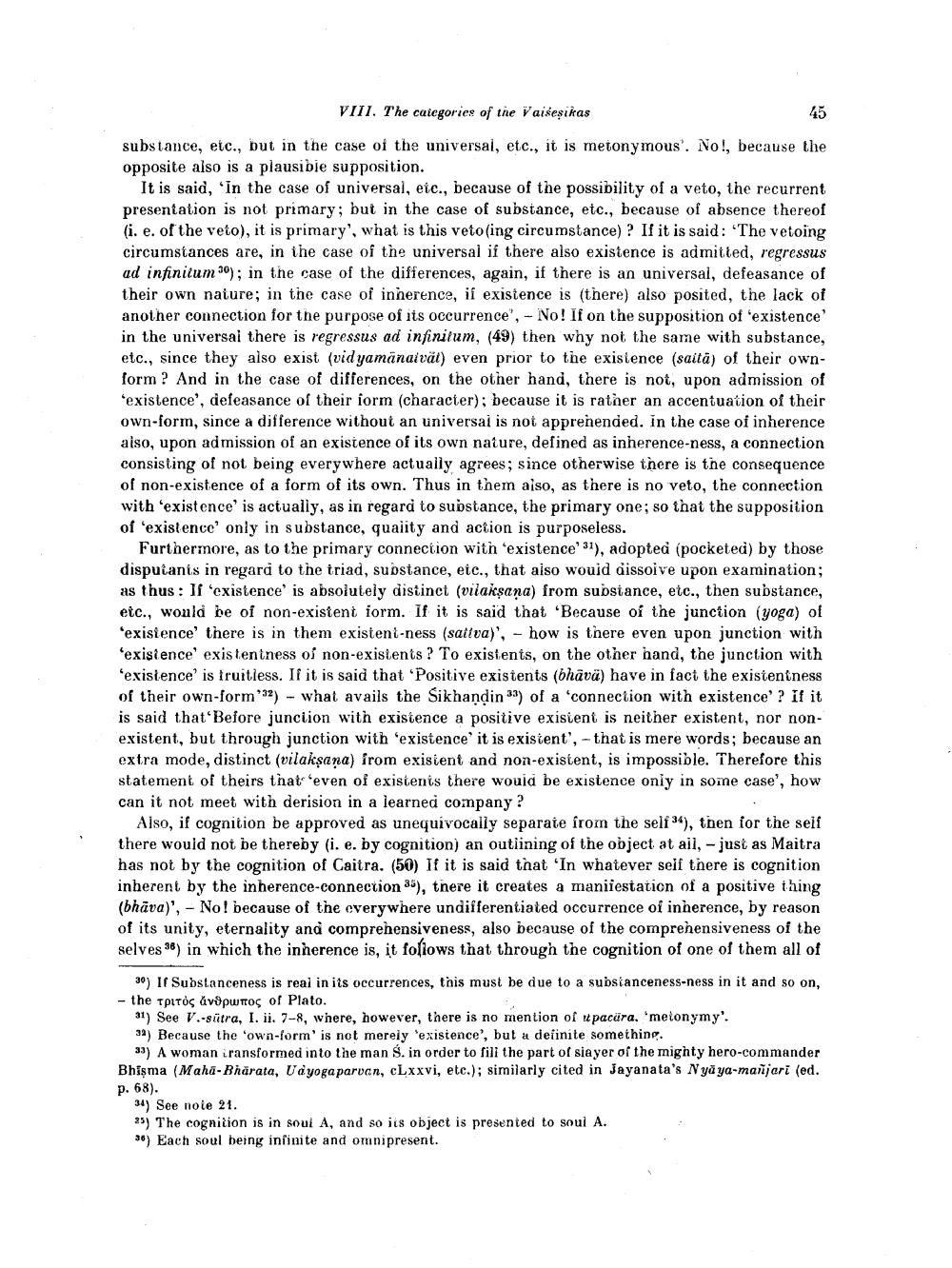________________
VIII. The categories of the Vaiseṣikas
45
substance, etc., but in the case of the universal, etc., it is metonymous'. No!, because the opposite also is a plausible supposition.
It is said, 'In the case of universal, etc., because of the possibility of a veto, the recurrent presentation is not primary; but in the case of substance, etc., because of absence thereof (i. e. of the veto), it is primary', what is this veto (ing circumstance)? If it is said: 'The vetoing circumstances are, in the case of the universal if there also existence is admitted, regressus ad infinitum 30); in the case of the differences, again, if there is an universal, defeasance of their own nature; in the case of inherence, if existence is (there) also posited, the lack of another connection for the purpose of its occurrence', - No! If on the supposition of 'existence' in the universal there is regressus ad infinitum, (49) then why not the same with substance, etc., since they also exist (vidyamänaivät) even prior to the existence (saita) of their ownform? And in the case of differences, on the other hand, there is not, upon admission of 'existence', defeasance of their form (character); because it is rather an accentuation of their own-form, since a difference without an universal is not apprehended. In the case of inherence also, upon admission of an existence of its own nature, defined as inherence-ness, a connection consisting of not being everywhere actually agrees; since otherwise there is the consequence of non-existence of a form of its own. Thus in them also, as there is no veto, the connection with 'existence' is actually, as in regard to substance, the primary one; so that the supposition of 'existence' only in substance, quality and action is purposeless.
Furthermore, as to the primary connection with 'existence' 31), adopted (pocketed) by those disputants in regard to the triad, substance, etc., that also would dissolve upon examination; as thus: If 'existence' is absolutely distinct (vilakṣana) from substance, etc., then substance, etc., would be of non-existent form. If it is said that 'Because of the junction (yoga) of 'existence' there is in them existent-ness (sattva)', - how is there even upon junction with 'existence' existentness of non-existents? To existents, on the other hand, the junction with 'existence' is truitless. If it is said that 'Positive existents (bhava) have in fact the existentness of their own-form'32) - what avails the Sikhandin 33) of a 'connection with existence'? If it is said that Before junction with existence a positive existent is neither existent, nor nonexistent, but through junction with 'existence' it is existent', - that is mere words; because an extra mode, distinct (vilakṣana) from existent and non-existent, is impossible. Therefore this statement of theirs that even of existents there would be existence only in some case', how can it not meet with derision in a learned company?
Also, if cognition be approved as unequivocally separate from the self 34), then for the self there would not be thereby (i. e. by cognition) an outlining of the object at all, - just as Maitra has not by the cognition of Caitra. (50) If it is said that 'In whatever self there is cognition inherent by the inherence-connection 35), there it creates a manifestation of a positive thing (bhava)', - No! because of the everywhere undifferentiated occurrence of inherence, by reason of its unity, eternality and comprehensiveness, also because of the comprehensiveness of the selves 3) in which the inherence is, it follows that through the cognition of one of them all of
30) If Substanceness is real in its occurrences, this must be due to a substanceness-ness in it and so on, the τριτὸς ἄνθρωπος of Plato.
31) See V.-sutra, I. ii. 7-8, where, however, there is no mention of upacara. 'metonymy'.
3) Because the 'own-form' is not merely 'existence', but a definite something.
33) A woman transformed into the man S. in order to fill the part of slayer of the mighty hero-commander Bhisma (Maha-Bharata, Udyogaparvan, cLxxvi, etc.); similarly cited in Jayanata's Nyaya-mañjarī (ed. p. 68).
34) See note 21.
25) The cognition is in soui A, and so its object is presented to soul A.
3) Each soul being infinite and omnipresent.




